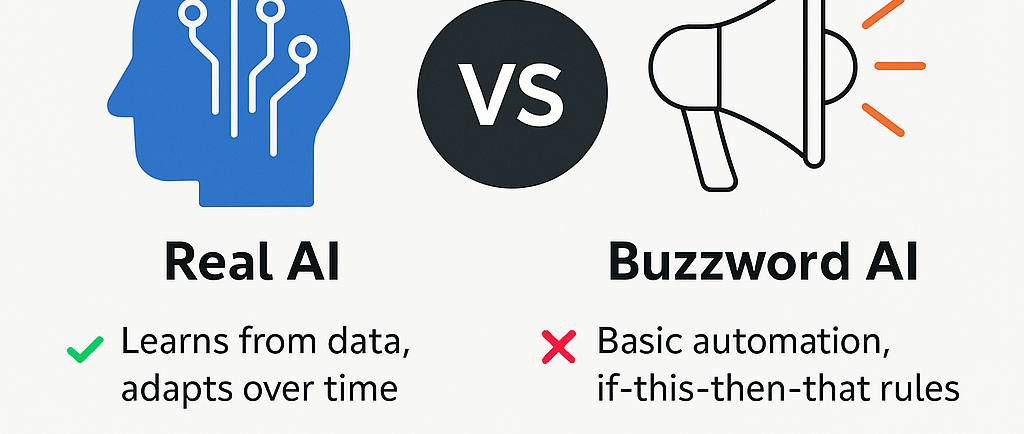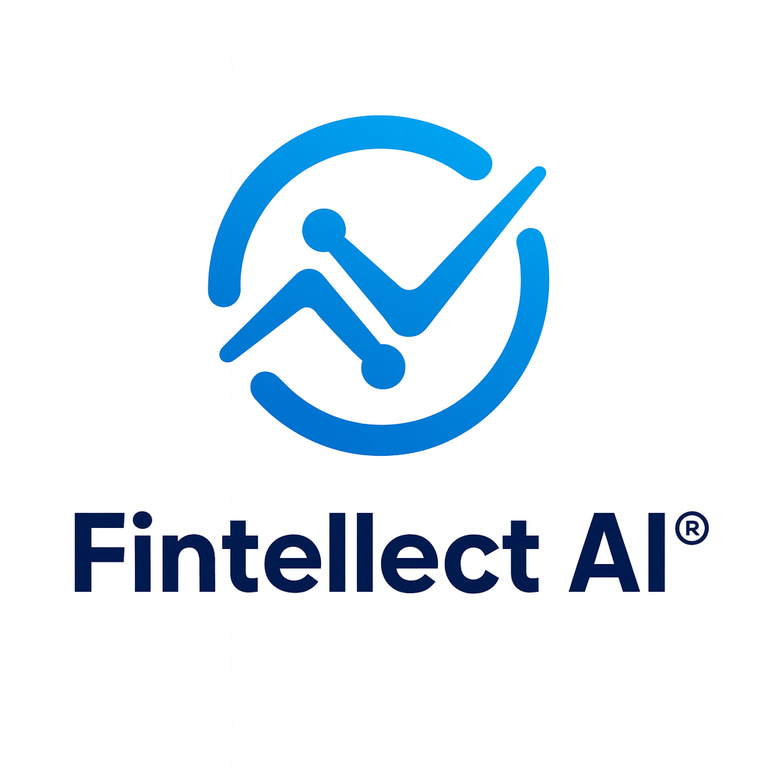AI in Finance: From Awareness to Mastery. Beyond the Hype: What AI Really Does in Finance
Behind the Buzz: What “AI” Often Means—And What It Doesn’t
CFO INSIGHTS
Zhivka Nedyalkova
4/9/20255 min read


Not All That Says “AI” Is Artificial Intelligence
In a world where “AI-powered” has become a marketing buzzword slapped onto nearly every software tool, it’s getting harder for finance professionals to distinguish true innovation from superficial upgrades. Many tools advertise AI capabilities—but behind the curtain, they offer little more than basic automation and dashboards.
Yet real AI in finance is transformative. It learns. It adapts. It helps make better decisions—not just faster ones. In this first article from our new series AI in Finance: From Awareness to Mastery, we’ll explore how to separate authentic AI from buzzword-heavy noise, and we’ll offer practical tools to help finance professionals evaluate what they’re really using—and what they should be using.
1. What Is “Real” AI in Finance? Let’s Define It
Let’s begin with a clear distinction:
✅ Real AI: Learns from data, adapts over time, performs decision-making based on patterns, and improves performance with more information.
❌ Buzzword AI: Relies on rule-based automation (“if-this-then-that”), outdated algorithms, vague descriptions like “smart-powered,” and lacks the ability to evolve or explain its logic.
Moreover, some tools—even modern ones—offer advanced automations that may not meet current regulatory or ethical standards. These are not "AI" in the true sense if they:
Exclude human-in-the-loop governance in critical decision areas (e.g., finance, audit, risk);
Cannot justify their outcomes through explainable logic;
Are inflexible and don’t learn or adapt based on the data they receive.
2. Why Buzzword AI Persists—and Why It’s a Problem
Buzzword AI is seductive. It’s easier to implement, market-friendly, and promises results without the complexity of machine learning infrastructure. For decision-makers who lack deep tech expertise, it can seem like the safer choice.
But there’s a cost: static insights, higher risk of misinterpretation, and tools that don't adapt to changes in the business environment.
Case in point: A dashboard tool might show past spending trends, but it won’t alert you to upcoming risks or shifts unless someone manually programs those alerts. Real AI tools go further—they spot anomalies before they become problems.
3. Real AI: The Core Functionalities that Make the Difference
Here are five pillars that distinguish real AI solutions in finance:
1. Real-Time Pattern Recognition
AI continuously scans data sources—transactions, invoices, performance metrics—and learns to identify evolving patterns. This means detecting unusual fluctuations in cash flow before they affect operations.
Example: An AI model detects that marketing costs are increasing outside the forecast and alerts the finance team before the issue affects liquidity.
2. Adaptive Forecasting
Unlike rule-based systems, AI models like ARIMA or logistic regression adapt their outputs based on data updates and seasonal fluctuations.
Example: An AI-powered forecast adjusts monthly based on sales behavior, economic factors, and supply chain indicators.
3. Contextual Decision Support
AI doesn’t just produce outputs—it offers explanations (“You are likely to face a cash shortage because expenses have increased 12% and revenue is flat.”).
Example: Tools with Explainable AI (XAI) offer transparency that allows finance teams to understand why the model suggests a course of action.
4. Regulatory-Aware Insights
Trustworthy AI incorporates human oversight. AI tools designed with compliance in mind include checkpoints, escalation protocols, and audit trails.
Example: AI detects a potential regulatory breach and flags it for review before filing, allowing a human to confirm the final step.
5. Continuous Learning
Machine learning enables AI to get smarter. Instead of repeating old outputs, models evolve.
Example: After a tax regulation changes, an AI tool adjusts forecast logic and budget allocations based on updated patterns in tax filing data.
4. What Is Not AI: Misleading Marketing in Practice
Let’s debunk a few recurring myths and clarify what they usually mean in practice:
❌ “AI-enhanced dashboard”
✅ What it means in practice: Often refers to static data visualizations with no actual learning or prediction involved. These dashboards simply present existing data in a polished format—without pattern recognition, adaptive models, or forward-looking analysis. The term “AI-enhanced” is often used for marketing purposes, even when no real AI capabilities are present.
We should be prepared to ask critical questions and look for clear evidence of AI capabilities, such as:
Use of machine learning models (e.g., regression, classification, time series prediction)
Demonstration of adaptability over time based on new data
Presence of explainability (XAI), showing how decisions are made
Integration of human-in-the-loop mechanisms for oversight
Transparent documentation of the AI model’s logic, training data, and boundaries
If these elements are missing, it’s likely not real AI—but just smart branding.
❌ “Smart-powered automation”
✅ What it means in practice: Predefined workflows with rigid logic and no learning. The system follows scripted actions and doesn’t evolve with new inputs or optimize over time.
Recommendation: Check for evidence of continuous improvement through learning loops. Ask: “How does the system improve over time without manual updates?”
❌ “AI forecast module”
✅ What it means in practice: Uses static assumptions to generate forecasts. Models are fixed, unable to detect shifting patterns, seasonal changes, or economic shocks unless manually updated.
Recommendation: Request clarification on how forecasts are generated. Does the model learn from past deviations or simply re-run fixed formulas?
❌ “Digital CFO”
✅ What it means in practice: A chatbot interface layered over a budgeting template. While it simulates interaction, it lacks contextual financial reasoning or true strategic advisory capacity.
Recommendation: Ask whether the system can explain its recommendations and adjust them based on evolving financial KPIs or market indicators.
❌ “Finance copilot”
✅ What it means in practice: Pre-formatted Excel sheets with embedded macros. These tools provide structure but lack the predictive, adaptive, or learning capacity of real AI.
Recommendation: Check whether any AI/ ML model is actually involved behind the scenes. Ask for details on the use of regression, classification, or time series prediction models.
5. The Risk of Unregulated Intelligence
Some of the newest trends in AI lack proper safeguards and explainability. While powerful, they can lead to critical risks in finance unless deployed with human-in-the-loop checks and strict transparency mechanisms.
👉 Finance professionals must demand systems that support intelligent collaboration—where machines accelerate decision-making but do not make irreversible decisions alone.
6. Intelligent Collaboration, Not Autonomy
The future isn’t AI replacing humans—it’s AI amplifying human judgment.
Real AI is built with the Human in the loop principle:
Humans guide the learning process
Review and approve critical outputs
Oversee compliance
Interpret AI recommendations in business context
AI works best not when it acts alone, but when it partners with professionals who can contextualize its findings. This is the core of Trustworthy AI.
7. Checklist: Is It Real AI? Or Just a Buzzword?
Here’s a simple checklist to spot real AI in finance:
✅ Uses terms like machine learning, adaptive, self-improving—and can explain how
✅ Offers contextual insights and predictions
✅ Includes human oversight in key decisions
✅ Learns and updates its models continuously
✅ Provides transparency into logic and outputs (XAI)
❌ Avoids technical details or real explanations
❌ Relies only on dashboards or static data
❌ Offers same result regardless of data quality or change
❌ Excludes human review in risk, compliance, audit
Knowing the Difference Is Power
Not all AI is created equal—and not all tools that claim AI truly use it. For finance professionals, understanding the difference between real and buzzword AI is no longer optional. It's essential for making smart, compliant, and future-ready decisions.
In the next article of our series, we’ll dive deeper into how to practically evaluate AI tools—including what questions to ask vendors, how to run pilot tests, and what internal skills are needed to extract real value from intelligent systems.
Stay tuned for Part 2 of AI in Finance: From Awareness to Mastery
